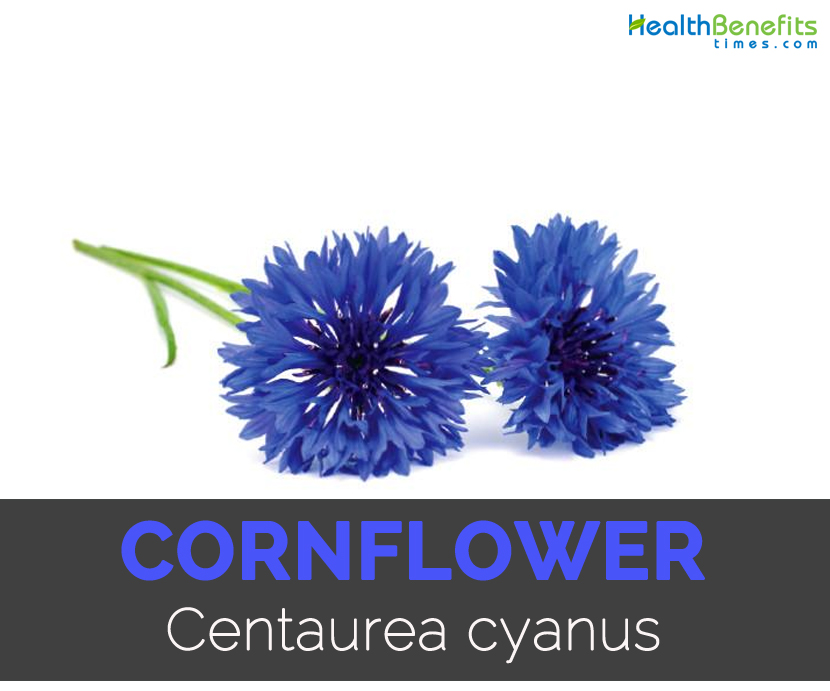| Cornflower Quick Facts | |
|---|---|
| Name: | Cornflower |
| Scientific Name: | Centaurea cyanus |
| Origin | Cornflower is indigenous to Europe. |
| Colors | Yellowish |
| Shapes | Flat |
| Taste | Resembles sweet cucumber |
| Health benefits | Treatment for constipation, Mouth wash for ulcers, Eye wash for conjunctivitis, Promote digestion, Detoxify liver, Helpful for stress and anxiety |
Leaves
Lower leaves have a curved lobe but the most of the leaves are narrow lanceolate which grows in whorls around long stems.
Flowers
The center flowers are darker and are surrounded by overlapping bracts about 1.5 inches across. Mostly Cornflowers are true blue but could be found in the shades of white, lavender, pink, maroon and two-tones.
Traditional uses
- The infusion is used for treating constipation, dropsy, kidney ailments and mouth wash for ulcers as well as bleeding gums.
- The eyewash prepared from cornflower blossoms for conjunctivitis, eye ailments and tired, strained or puffy eyes.
- It improves resistance to infections.
- The tea is used for promoting digestion and also detoxifies liver.
- Flower bud infusion is used for treating urinary tract infections.
- When used internally as a tea helps to ward off common cold.
- Seeds infusion is used in Europe to cure constipation.
- Apply the petals infusion internally for treating yeast infections.
- It stops bleeding in open wounds as well as bleeding gums.
- Apply the crushed leaves as a poultice to aching muscles, bruises and inflamed joints.
- The infusion of flower heads (dried or fresh) is used as a wash on scalp to eliminate dandruff.
- It possesses astringent qualities which help to treat dark circles and puffy eyes.
- The flowers paste is useful in bruising.
- It is helpful for ulcers and lowers the appearance of wrinkles.
- The leaves decoction is used for rheumatic complaints and if used as a hair rinse treats scalp eczema.
- It is used to regulate menstrual disorder.
- Its infusion can be used in the treatment of mouth ulcers and bleeding gums.
- It is used to cure irritated and inflamed skin.
- It is used in strengthening nails and prevents nail infections.
- It is beneficial for those people experiencing stress, anxiety, depression and other nervous system disorders.
Precautions
- People having an allergy should completely avoid it.
- Consult the health practitioner by the people having other illnesses, disorders and medical conditions.
How to Eat
- Flowers are consumed raw or cooked or added to salads and vegetables.
- Young shoots are also consumed.
- It is also used in desserts.
- Petals are used in cornbread muffins.
- It is used as a garnish.
Other Facts
- The leaves are arranged alternately on stem.
- Flowers are arranged in flower heads on top of flowering stem. Flower heads are located centrally and is made of disk florets.
- Flowers are found in various shades of blue, pink, white, purple, red and maroon color.
- Cornflower could produce single and double blooms and contains both reproductive organs.
- Flowers being a rich source of nectar attract butterflies and bees which are the main pollinators of the plant.
- It is propagated by seed.
- It is also used as a source of blue dye.
- Cornflower is regarded as the national flower of Estonia.
- It is an annual plant which completes its life cycle in one year.
- The edible flowers have sweet cucumber like taste.
- The honey prepared from these flowers is regarded to be the best.
References:
https://www.itis.gov/servlet/SingleRpt/SingleRpt?search_topic=TSN&search_value=36954#null
https://www.pfaf.org/user/Plant.aspx?LatinName=Centaurea+cyanus
https://www.botanical.com/botanical/mgmh/c/cornf102.html
http://herbs-treatandtaste.blogspot.com/2011/06/cornflowers-history-superstitions-uses.html
http://www.cloverleaffarmherbs.com/cornflower/
https://www.onlyfoods.net/cornflower.html
http://www.home-remedies-for-you.com/herbs/cornflower.html
https://hellodoktor.com/herbal/cornflower/
https://www.herbs2000.com/herbs/herbs_cornflower.htm
https://www.herbco.com/p-1297-cornflower.aspx
http://www.softschools.com/facts/plants/cornflower_centaurea_facts/2175/
https://funflowerfacts.com/2013/05/27/fun-flower-facts-cornflower-centaurea/
Comments
comments
